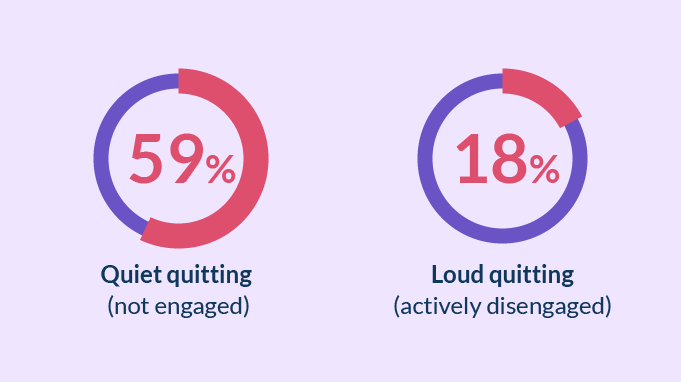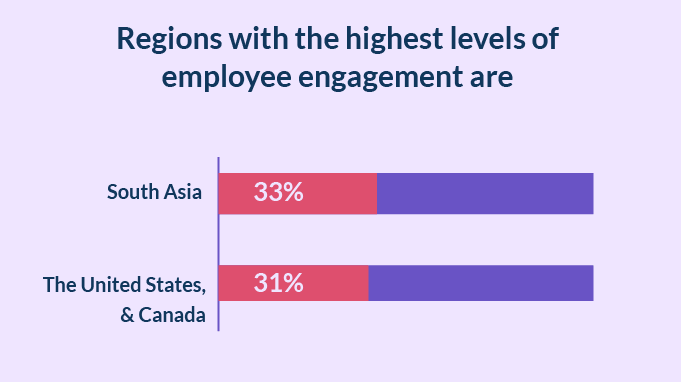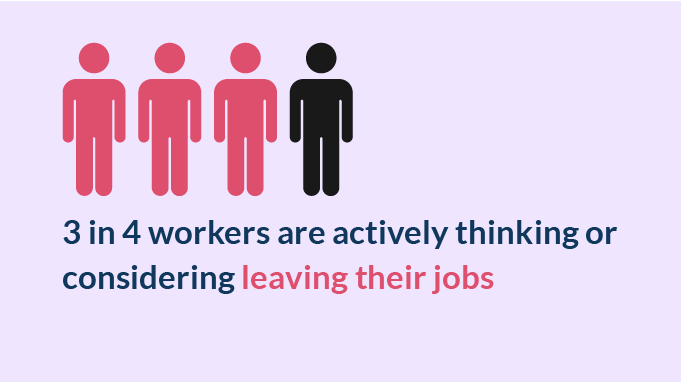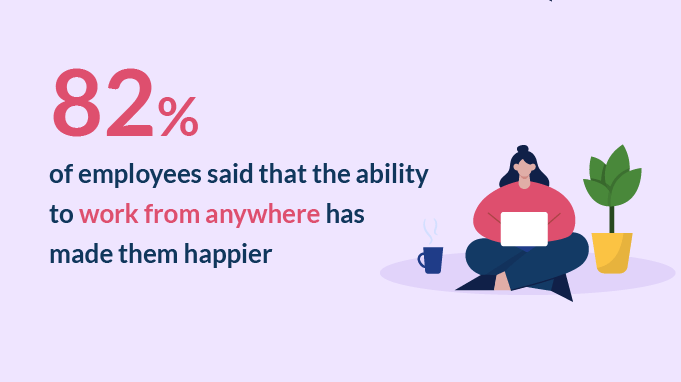10 Must-Know Employee Engagement Statistics For 2024
Employee engagement is the driving force behind exceptional workplaces. It embodies the commitment and enthusiasm employees bring to their roles.
Yet, comprehending the depth of employee engagement requires more than observation. It demands data.
After all, a data-backed approach empowers organizations to build an engaging environment.
This is where statistics come into play.
The latest employee engagement statistics for 2024 highlight some tremendous insights. Recent research reveals that companies with highly engaged employees outperform their peers in vital areas such as productivity, profitability,and customer satisfaction. This suggests a clear correlation between employee engagement and overall business success.
As we explore employee engagement statistics, we unravel a narrative that speaks volumes about the synergy between engaged teams and thriving businesses. These statistical insights showcase the formidable power held within fostering a culture of engagement.
Key Takeaways
- 10 Employee Engagement Statistics for 2024
- A Brief Overview of Employee Engagement
- Importance of Employee Engagement
10 Key Employee Engagement Statistics For 2024
1. More than half of employees (59%) are quiet quitting (not engaged), and 18% are loud (actively disengaged).

In a recent study conducted by Gallup, we've observed a concerning trend in employee engagement. A staggering 59% of employees fall into the category of 'quiet quitting.'
"Quiet quitting." describes leaving a job after fulfilling very minimal responsibilities. Quite quitters express their disengagement through a lack of enthusiasm in their tasks. Additionally, 18% of our workforce is classified as 'loud' or 'actively disengaged.' These employees openly express their dissatisfaction.
The data from this study underscores the pressing need for a closer examination of employee engagement strategies.
2. Regions with the highest levels of employee engagement are South Asia (33%), the United States, and Canada (31%)

Some interesting differences surface when one compares employee engagement levels between different rates.
According to a Gallup report, South Asia emerges as a leader in fostering workplace engagement. An impressive 33% of employees were actively involved and motivated. Following closely behind are the United States and Canada, with 31%.
In line with the same report, the European region has the lowest employee engagement at 13%.
These statistics shed light on regional variations in employee engagement. They emphasize the need for organizations to tailor their engagement strategies. Keeping in mind the unique dynamics of each geographic area.
3. Companies with engaged workforces have higher earnings per share.
A study indicates that businesses with actively engaged employees experience increased Earnings Per Share (EPS).
Additionally, these companies demonstrated a quicker recovery rate from the 2008 recession. Showcasing the positive correlation between employee engagement and financial resilience during economic challenges.
The study observed that companies with engaged workforces had an advantage in regaining and growing EPS. The earnings per share can be recovered faster than their industry equivalents.
4. Costing the world $8.8 trillion in lost productivity

The global impact of disengaged employees, whether not engaged or actively disengaged, is striking. It results in a staggering loss of $8.8 trillion in productivity.
This significant figure underscores the pervasive economic consequences of a disengaged workforce.
Therefore, recognizing the profound economic implications, organizations must prioritize initiatives. The initiatives should effectively address and enhance employee engagement.
Hence, organizations must recognize the critical need to address and improve employee engagement.
5. Passion over pay

Nearly two-thirds of millennials strongly prefer a lower-paying job that ignites their passion over a higher-paying job that they find dull. This statistic highlights the generational shift in priorities, where meaningful work and a sense of fulfillment outweigh financial compensation.
It underscores how millennials prioritize intrinsic values, seeking roles that align with their passions. It also prompts employers to consider the importance of cultivating engaging and purpose-driven work environments.
6. Employees considering leaving their jobs

The statistic reveals that 75% of workers are actively contemplating or considering leaving their current jobs. This indicates a widespread sentiment of dissatisfaction or discontent within the workforce.
The reasons behind this inclination could range from factors like:
- inadequate career growth opportunities
- lack of recognition, poor work-life balance
- unsatisfactory workplace culture
Such a high percentage contemplating leaving their jobs could have significant implications for companies.
It underscores the critical need for employers to reassess their employee retention strategies, focus on creating fulfilling work environments, and address the underlying issues causing this widespread desire to leave.
7. 81.9% of employees agree that recognition for their contributions improves their engagement
The statistic highlights that a significant majority, approximately 82% of employees,acknowledge the positive impact of recognition on their engagement at work.
When employees feel appreciated and valued for their contributions, it directly correlates with increased engagement.
It underscores the importance of a culture of appreciation within organizations. Employers should prioritize acknowledging and celebrating employees' contributions to foster a more engaged and motivated workforce.
Recognizing employees boosts morale and creates a more positive and supportive work environment. Ultimately, this benefits both employees and the organization as a whole.
8. Work from anywhere makes employees happy

82% of employees have found their happiness meter rocketing skyward. Thanks to the newfound freedom of working from wherever they please.
This flexibility has turned the tables on traditional work norms.
This data paints a vibrant picture of how the freedom to work remotely isn't just a perk. It's a happiness booster. For employers, understanding and embracing this need for flexibility could be the golden ticket to a more content, motivated, and loyal workforce.
9. 68% of HR professionals agreed that employee recognition positively impacts retention, while 56% said it also helps with recruitment.
SHRM study shows employee recognition's impact on retention and recruitment.
68% of HR professionals recognize the positive influence of employee recognition on retaining valuable talent. Also, 56% think recognition is vital for attracting new talent and crucial in recruitment.
These results underscore the strategic value of fostering a culture of appreciation within organizations. An appreciative work culture helps in employee retention. Simultaneously, it positions companies attractively to attract and retain top talent.
10. Organizations with highly engaged employees have happy customers

Quantum Workplace survey indicates a strong correlation between employee engagement and increased customer satisfaction. 72% of executives strongly agree that organizations with highly engaged employees usually have satisfied customers.
The connection stems from the profound dedication engaged employees demonstrate towards their work. When employees are deeply invested in their roles, their commitment naturally extends to customer interactions.
This study implies that engaged employees become a driving force behind external customer satisfaction.
The Statistics in a Nutshell

These statistics paint a vivid picture of today’s workforce. It highlights a pressing need for organizations to tackle disengagement, with over half of the employees quietly quitting. Notably, they shed light on regions excelling in fostering employee engagement, emphasizing the need for tailored strategies across diverse locations.
Through these statistics, we now know that millennials prioritize passion over pay. And a considerable number of workers contemplate leaving. In a way, signaling widespread job dissatisfaction.
On a positive note, effective recognition and remote work flexibility are powerful tools for boosting employee engagement. Companies that understand these insights can:
- Navigate Challenges
- Boost morale
- Build a positive employer reputation
- Influence customer satisfaction
The holistic approach to these findings equips organizations to proactively address workforce dynamics and cultivate a resilient, engaged, and satisfied employee base.
What is Employee Engagement?
Employee Engagement refers to the dedication and commitment of an employee towards their work and organization. It goes beyond just being pleased or content with one's job responsibilities.
An engaged worker feels a genuine attachment to their role. Not just working for a salary or potential advancement. They actively care about the quality of their contributions, their coworkers, and the company's overall success.
An engaged employee does not view their job as just a paycheck. But feels invented in the work itself and achieving positive results.
Thus, employee engagement is about:
-
What dedication and investment do employees have towards their work and the organization?
-
What is the quality of interaction and collaboration occurring among employees?
When people are financially invested, they want a return. When people are emotionally invested, they want to contribute.
~Simon Sinek, Author and Speaker.
We are now aware of the meaning of employee engagement. However, it is equally vital to understand the significance or importance of employee engagement.
Importance of Employee Engagement
The heartbeat of every successful organization lies within the passion and commitment of its workforce. This fundamental truth underscores the critical importance of employee engagement.
1. Enhanced Productivity

According to a Gallup study, engaged employees are more present and productive.
Engaged employees are more focused, motivated, and committed to their work. Employees who feel connected to their roles and the organization's objectives invest the discretionary effort to excel in their work.
Further, boosting overall productivity.
2. Improved Employee Retention

Companies with high levels of employee engagement often experience lower turnover rates.
Upon joining a company, employees bring expectations and aspirations. Failing to meet these can drive them to explore other opportunities. Conversely, implementing effective engagement measures enhances satisfaction levels, fostering long-term commitment and bolstering retention rates.
Consequently, employee engagement is a cost-effective strategy to mitigate turnover expenses and fortify retention efforts.
3. Increased Innovation and Creativity

Engaged employees become catalysts for innovation and creativity within the workplace. In an environment where engagement is promoted, a culture of innovation flourishes. It also encourages employees to share their inventive ideas and suggestions confidently.
Thus paving the way for fresh approaches and creative solutions to challenges.
4. Better Customer Satisfaction

As per Harvard Business Review, engaged employees create better customer experiences.
Engaged employees provide outstanding customer service due to their commitment and enthusiasm.
This leads to happier interactions with customers. This will result in higher satisfaction and positive word-of-mouth for the company.
5. Improved Company Reputation

Take time to appreciate employees and they will reciprocate in a thousand ways.
~Bob Nelson
Organizations with highly engaged employees stand out for their positive employer branding. It simplifies attracting and retaining top talent while elevating the company's image and credibility.
The strength of this reputation hinges on consistent efforts to engage employees.
Conclusion
The realm of employee engagement isn't just about statistics. The narrative illustrates the profound connection between engaged teams and flourishing businesses.
The data showcased here unveils the stark reality of disengagement's financial toll. The yearning for purpose-driven work among millennials and the transformative power of recognition and flexibility.
Understanding the significance of employee engagement is about fostering an environment where individuals thrive.
FAQs

1. What is the highest percentage of engaged employees ever-recorded?
Ans- Gallup notes a decline in US employee engagement, hitting a peak at 36% in 2020 (highest ever-recorded). Subsequent years saw a decrease to 34% in 2021, 33% in 2022, and a continued trend in 2023, registering only 31% engaged employees.
2. What is Engagement Rate Index?
Ans- The Engagement Rate Index is a metric indicating the level of involvement within a specific context. Commonly used in areas like marketing or social media analytics.
It represents the percentage of actively engaged individuals relative to the total audience, offering insights into the effectiveness of campaigns or initiatives.
3. How does employee engagement impact retention?
Ans- Employee engagement significantly influences retention by fostering a positive workplace experience. When employees feel connected, valued, and motivated, they are more likely to stay with the company.
Engaged employees often exhibit higher job satisfaction. Further, leading to reduced turnover rates and increased organizational stability.















